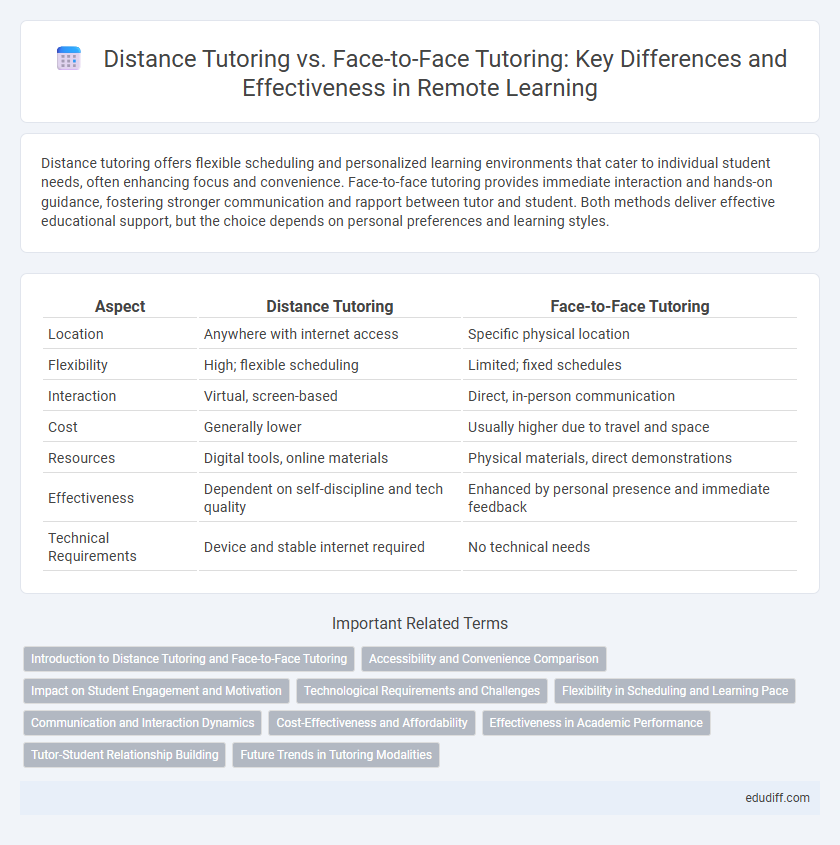Distance tutoring offers flexible scheduling and personalized learning environments that cater to individual student needs, often enhancing focus and convenience. Face-to-face tutoring provides immediate interaction and hands-on guidance, fostering stronger communication and rapport between tutor and student. Both methods deliver effective educational support, but the choice depends on personal preferences and learning styles.
Table of Comparison
| Aspect | Distance Tutoring | Face-to-Face Tutoring |
|---|---|---|
| Location | Anywhere with internet access | Specific physical location |
| Flexibility | High; flexible scheduling | Limited; fixed schedules |
| Interaction | Virtual, screen-based | Direct, in-person communication |
| Cost | Generally lower | Usually higher due to travel and space |
| Resources | Digital tools, online materials | Physical materials, direct demonstrations |
| Effectiveness | Dependent on self-discipline and tech quality | Enhanced by personal presence and immediate feedback |
| Technical Requirements | Device and stable internet required | No technical needs |
Introduction to Distance Tutoring and Face-to-Face Tutoring
Distance tutoring utilizes digital platforms to connect students and tutors remotely, offering flexible scheduling and access to diverse educational resources worldwide. Face-to-face tutoring provides direct personal interaction, enabling immediate feedback and customized support within a physical learning environment. Both methods aim to enhance academic performance but differ in delivery, interaction, and accessibility factors.
Accessibility and Convenience Comparison
Distance tutoring offers unparalleled accessibility, allowing students to connect with expert tutors worldwide regardless of location or time constraints. This mode provides significant convenience by enabling flexible scheduling and eliminating the need for commuting, which is especially beneficial for busy individuals or those in remote areas. In contrast, face-to-face tutoring may limit accessibility due to geographic barriers and fixed appointment times but can offer personalized interaction that some learners find invaluable.
Impact on Student Engagement and Motivation
Distance tutoring leverages interactive technologies and flexible scheduling to enhance student engagement by providing personalized learning experiences tailored to individual needs. Face-to-face tutoring fosters immediate emotional connection and real-time feedback, which can significantly boost student motivation through direct interpersonal interaction. Studies show a blend of both methods often results in the highest levels of sustained student engagement and intrinsic motivation.
Technological Requirements and Challenges
Distance tutoring requires reliable high-speed internet, compatible devices, and up-to-date software to ensure seamless communication and access to digital learning resources. Technological challenges include connectivity issues, software glitches, and the need for technical proficiency from both tutors and students. Face-to-face tutoring avoids these technological barriers but lacks the flexibility and accessibility provided by online platforms.
Flexibility in Scheduling and Learning Pace
Distance tutoring offers unparalleled flexibility in scheduling, allowing students to access lessons from any location and at times that suit their individual routines. This mode of learning accommodates varied pacing, enabling learners to review materials repeatedly or accelerate through topics according to their personal comprehension levels. In contrast, face-to-face tutoring typically requires fixed appointment times and a standardized pace, which may not fully adapt to each student's unique learning needs.
Communication and Interaction Dynamics
Distance tutoring leverages digital platforms enabling real-time communication through video calls, chat, and interactive whiteboards, which can enhance flexibility but may limit non-verbal cues essential for nuanced understanding. Face-to-face tutoring fosters direct interpersonal interaction, allowing immediate feedback, richer body language interpretation, and stronger rapport building that facilitates personalized learning experiences. The dynamics of communication in distance tutoring depend heavily on technology reliability and user proficiency, while face-to-face settings benefit from natural conversational flow and physical presence.
Cost-Effectiveness and Affordability
Distance tutoring significantly reduces costs by eliminating commute expenses and allowing access to diverse, competitively priced instructors globally. Face-to-face tutoring often involves higher fees due to physical location rentals and limited tutor availability within specific areas. Online platforms typically offer flexible pricing models, making distance tutoring a more affordable and cost-effective option for many students.
Effectiveness in Academic Performance
Distance tutoring has demonstrated comparable effectiveness to face-to-face tutoring in improving academic performance across various subjects, particularly when utilizing interactive digital platforms and real-time feedback. Studies reveal that personalized learning trajectories and adaptive content delivery through virtual environments contribute significantly to student engagement and knowledge retention. Face-to-face tutoring, however, often benefits from immediate non-verbal communication cues, which can enhance understanding and motivation in certain learners.
Tutor-Student Relationship Building
Distance tutoring leverages digital platforms to facilitate frequent and flexible interactions, enabling personalized feedback that fosters strong tutor-student relationships despite physical separation. Advanced communication tools like video calls and instant messaging promote engagement and immediate clarification, enhancing rapport and trust. Face-to-face tutoring naturally supports non-verbal cues and spontaneous interactions, but well-structured online environments can equally cultivate meaningful connections through consistent and interactive dialogue.
Future Trends in Tutoring Modalities
Distance tutoring leverages advanced digital platforms and AI-driven analytics to offer personalized learning experiences that adapt in real-time to student needs, predicting a significant rise in hybrid tutoring models combining online and face-to-face elements. Emerging technologies such as virtual reality (VR) and augmented reality (AR) are set to revolutionize remote education by providing immersive, interactive environments that closely replicate in-person engagement. Future trends indicate a growing emphasis on data-driven insights and seamless integration of multiple modalities to enhance student outcomes and accessibility in both distance and face-to-face tutoring.
Distance tutoring vs face-to-face tutoring Infographic

 edudiff.com
edudiff.com